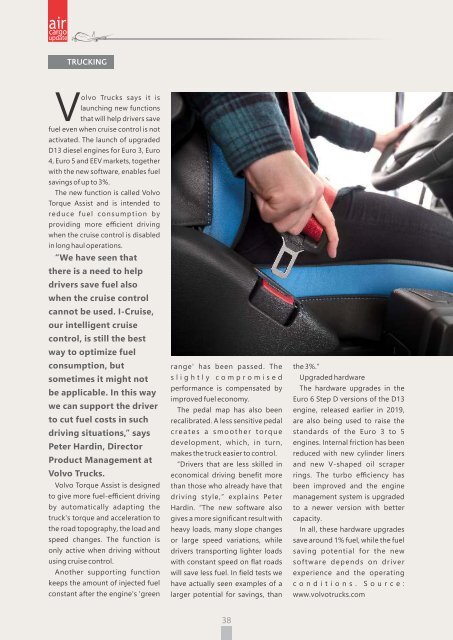Create successful ePaper yourself
Turn your PDF publications into a flip-book with our unique Google optimized e-Paper software.
TRUCKING<br />
olvo Trucks says it is<br />
Vlaunching new functions<br />
that will help drivers save<br />
fuel even when cruise control is not<br />
activated. The launch of upgraded<br />
D13 diesel engines for Euro 3, Euro<br />
4, Euro 5 and EEV markets, together<br />
with the new software, enables fuel<br />
savings of up to 3%.<br />
The new function is called Volvo<br />
Torque Assist and is intended to<br />
reduce fuel consumption by<br />
providing more efficient driving<br />
when the cruise control is disabled<br />
in long haul operations.<br />
“We have seen that<br />
there is a need to help<br />
drivers save fuel also<br />
when the cruise control<br />
cannot be used. I-Cruise,<br />
our intelligent cruise<br />
control, is still the best<br />
way to optimize fuel<br />
consumption, but<br />
sometimes it might not<br />
be applicable. In this way<br />
we can support the driver<br />
to cut fuel costs in such<br />
driving situations,” says<br />
Peter Hardin, Director<br />
Product Management at<br />
Volvo Trucks.<br />
Volvo Torque Assist is designed<br />
to give more fuel-efficient driving<br />
by automatically adapting the<br />
truck's torque and acceleration to<br />
the road topography, the load and<br />
speed changes. The function is<br />
only active when driving without<br />
using cruise control.<br />
Another supporting function<br />
keeps the amount of injected fuel<br />
constant after the engine's 'green<br />
range' has been passed. The<br />
s l i g h t l y c o m p r o m i s e d<br />
performance is compensated by<br />
improved fuel economy.<br />
The pedal map has also been<br />
recalibrated. A less sensitive pedal<br />
c r e a t e s a s m o o t h e r t o r q u e<br />
development, which, in turn,<br />
makes the truck easier to control.<br />
“Drivers that are less skilled in<br />
economical driving benefit more<br />
than those who already have that<br />
driving style,” explains Peter<br />
Hardin. “The new software also<br />
gives a more significant result with<br />
heavy loads, many slope changes<br />
or large speed variations, while<br />
drivers transporting lighter loads<br />
with constant speed on flat roads<br />
will save less fuel. In field tests we<br />
have actually seen examples of a<br />
larger potential for savings, than<br />
the 3%.”<br />
Upgraded hardware<br />
The hardware upgrades in the<br />
Euro 6 Step D versions of the D13<br />
engine, released earlier in 2019,<br />
are also being used to raise the<br />
standards of the Euro 3 to 5<br />
engines. Internal friction has been<br />
reduced with new cylinder liners<br />
and new V-shaped oil scraper<br />
rings. The turbo efficiency has<br />
been improved and the engine<br />
management system is upgraded<br />
to a newer version with better<br />
capacity.<br />
In all, these hardware upgrades<br />
save around 1% fuel, while the fuel<br />
saving potential for the new<br />
software depends on driver<br />
experience and the operating<br />
c o n d i t i o n s . S o u r c e :<br />
www.volvotrucks.com

















